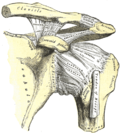Coracoclavicular ligament
Coracoclavicular Ligament[edit]
The coracoclavicular ligament is a crucial anatomical structure that connects the clavicle (collarbone) to the coracoid process of the scapula (shoulder blade). It plays a significant role in stabilizing the acromioclavicular joint (AC joint), which is located at the point where the clavicle meets the acromion process of the scapula.
Anatomy[edit]
The coracoclavicular ligament consists of two distinct ligaments: the trapezoid ligament and the conoid ligament. These ligaments are named based on their shape and attachment points. The trapezoid ligament is broader and attaches to the lateral aspect of the clavicle, while the conoid ligament is more conical and attaches to the medial aspect of the clavicle.
The trapezoid ligament originates from the coracoid process and inserts into the trapezoid line on the clavicle. On the other hand, the conoid ligament originates from the coracoid process and inserts into the conoid tubercle on the clavicle. Together, these ligaments provide stability and prevent excessive upward displacement of the clavicle.
Function[edit]
The primary function of the coracoclavicular ligament is to provide stability to the AC joint. It acts as a strong support structure, preventing the clavicle from dislocating or separating from the scapula during various shoulder movements. The ligament also helps to transmit forces from the upper limb to the axial skeleton, allowing for efficient movement and load-bearing.
Injuries[edit]
Injuries to the coracoclavicular ligament can occur due to trauma, such as a direct blow to the shoulder or a fall onto an outstretched arm. These injuries are commonly referred to as AC joint separations or dislocations. The severity of the injury can vary, ranging from a mild sprain to a complete tear of the ligament.
Treatment for coracoclavicular ligament injuries depends on the severity and the individual's specific circumstances. Conservative management, including rest, ice, compression, and elevation (RICE), along with physical therapy, is often sufficient for mild to moderate injuries. However, severe cases may require surgical intervention to repair or reconstruct the damaged ligament.
Conclusion[edit]
The coracoclavicular ligament is a vital structure that provides stability to the AC joint and plays a crucial role in shoulder function. Understanding its anatomy, function, and potential injuries is essential for healthcare professionals involved in the diagnosis and treatment of shoulder-related conditions.
-
Coracoclavicular ligament - Image 1
-
Coracoclavicular ligament - Image 2
Ad. Transform your life with W8MD's Budget GLP-1 injections from $75


W8MD offers a medical weight loss program to lose weight in Philadelphia. Our physician-supervised medical weight loss provides:
- Weight loss injections in NYC (generic and brand names):
- Zepbound / Mounjaro, Wegovy / Ozempic, Saxenda
- Most insurances accepted or discounted self-pay rates. We will obtain insurance prior authorizations if needed.
- Generic GLP1 weight loss injections from $75 for the starting dose.
- Also offer prescription weight loss medications including Phentermine, Qsymia, Diethylpropion, Contrave etc.
NYC weight loss doctor appointmentsNYC weight loss doctor appointments
Start your NYC weight loss journey today at our NYC medical weight loss and Philadelphia medical weight loss clinics.
- Call 718-946-5500 to lose weight in NYC or for medical weight loss in Philadelphia 215-676-2334.
- Tags:NYC medical weight loss, Philadelphia lose weight Zepbound NYC, Budget GLP1 weight loss injections, Wegovy Philadelphia, Wegovy NYC, Philadelphia medical weight loss, Brookly weight loss and Wegovy NYC
|
WikiMD's Wellness Encyclopedia |
| Let Food Be Thy Medicine Medicine Thy Food - Hippocrates |
Medical Disclaimer: WikiMD is not a substitute for professional medical advice. The information on WikiMD is provided as an information resource only, may be incorrect, outdated or misleading, and is not to be used or relied on for any diagnostic or treatment purposes. Please consult your health care provider before making any healthcare decisions or for guidance about a specific medical condition. WikiMD expressly disclaims responsibility, and shall have no liability, for any damages, loss, injury, or liability whatsoever suffered as a result of your reliance on the information contained in this site. By visiting this site you agree to the foregoing terms and conditions, which may from time to time be changed or supplemented by WikiMD. If you do not agree to the foregoing terms and conditions, you should not enter or use this site. See full disclaimer.
Credits:Most images are courtesy of Wikimedia commons, and templates, categories Wikipedia, licensed under CC BY SA or similar.
Translate this page: - East Asian
中文,
日本,
한국어,
South Asian
हिन्दी,
தமிழ்,
తెలుగు,
Urdu,
ಕನ್ನಡ,
Southeast Asian
Indonesian,
Vietnamese,
Thai,
မြန်မာဘာသာ,
বাংলা
European
español,
Deutsch,
français,
Greek,
português do Brasil,
polski,
română,
русский,
Nederlands,
norsk,
svenska,
suomi,
Italian
Middle Eastern & African
عربى,
Turkish,
Persian,
Hebrew,
Afrikaans,
isiZulu,
Kiswahili,
Other
Bulgarian,
Hungarian,
Czech,
Swedish,
മലയാളം,
मराठी,
ਪੰਜਾਬੀ,
ગુજરાતી,
Portuguese,
Ukrainian


